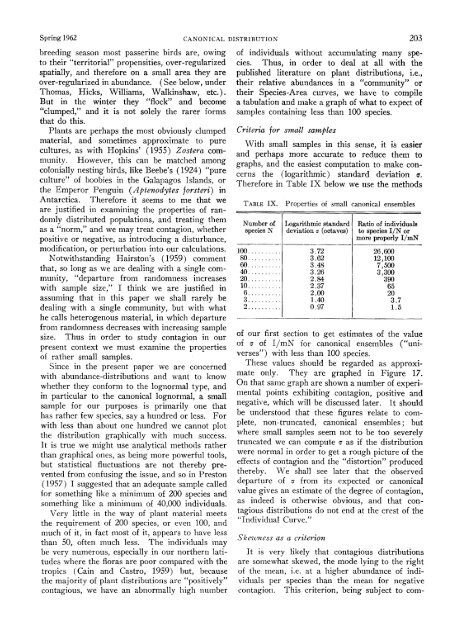The Canonical Distribution of Commonness and Rarity: Part I F. W ...
The Canonical Distribution of Commonness and Rarity: Part I F. W ...
The Canonical Distribution of Commonness and Rarity: Part I F. W ...
Create successful ePaper yourself
Turn your PDF publications into a flip-book with our unique Google optimized e-Paper software.
Spring 1962<br />
CANONICAL DISTRIBUTION<br />
breeding season most passerine birds are, o~vi~lg <strong>of</strong> individuals without accumulating many speto<br />
their "territorial" propensities, over-regularized<br />
spatially, <strong>and</strong> therefore on a small area they are<br />
over-rqgularized in abundance. (See below, under<br />
Thomas, Hicks, Williams, I'dalkinshaw, etc.) .<br />
cies. Thus, in order to deal at all with the<br />
But in the winter they "flock" <strong>and</strong> become<br />
"clumped," <strong>and</strong> it is not solely the rarer forms<br />
that do this.<br />
Plants are perhaps the most obviously clumped<br />
material, <strong>and</strong> sometimes approximate to pure<br />
cultures, as with Hopkins' (1955) Zostera community.<br />
However, this can be matched among<br />
colonially nesting birds, like Beebe's ( 1924) "pure<br />
culture" <strong>of</strong> boobies in the Galapagos Isl<strong>and</strong>s. or<br />
the Emperor Penguin (Apfertodytes forsteri) in<br />
Antarctica. <strong>The</strong>refore it seems to me that we<br />
are justified in examining the properties <strong>of</strong> r<strong>and</strong>omly<br />
distributed populations, <strong>and</strong> treating them<br />
as a "norm," <strong>and</strong> we nlay treat contagion, whether<br />
positive or negative, as introducing a disturbance,<br />
modification, or perturbation into our calculations.<br />
Notwithst<strong>and</strong>ing Hairston's ( 1959) comment<br />
that, so long as vie are dealing with a single community,<br />
"departure from r<strong>and</strong>omness increases<br />
with sample size," I thillk we are justified in<br />
assuming that in this paper we shall rarely be<br />
dealing .n-it11 a single community, but with what<br />
he calls heterogenous material, in which departure<br />
fro111 r<strong>and</strong>omness decreases with increasing saniple<br />
size. Thus in order to study contagion in our<br />
present context we must examine the properties<br />
<strong>of</strong> rather small samples.<br />
Since in the present paper we are concerned<br />
with abundance-distributions <strong>and</strong> want to know<br />
whether they conforn~ to the lognormal type, <strong>and</strong><br />
in particular to the canonical lognormal, a small<br />
sample for our purposes is primarily one that<br />
has rather few species, say a hundred or less. For<br />
with less than about one hundred we cannot plot<br />
the distribution graphically with much success.<br />
It is true we might use analytical methods rather<br />
than graphical ones, as being more powerful tools,<br />
but statistical fluctuations are not thereby prevented<br />
from confusing the issue, <strong>and</strong> so in Preston<br />
(1957) I suggested that an adequate sample called<br />
for something like a minimum <strong>of</strong> 200 species <strong>and</strong><br />
something like a mitlimum <strong>of</strong> 30,000 individuals.<br />
Very little in the way <strong>of</strong> plant material meets<br />
the requirement <strong>of</strong> 200 species. or eveti 100. <strong>and</strong><br />
much <strong>of</strong> it, in fact most <strong>of</strong> it, appears to have less<br />
than 50, <strong>of</strong>ten much less. <strong>The</strong> individuals may<br />
be very numerous, especially in our northern latitudes<br />
where the floras are poor compared with the<br />
tropics (Cain <strong>and</strong> Castro, 1959) but, because<br />
the majority <strong>of</strong> plant distributions are "positively"<br />
contagious, we have an abnormally high ntltnber<br />
203<br />
published literature on plant distributions, i.e.,<br />
their relative abundances in a "community" or<br />
their Species-Area curves, we have to compile<br />
a tabulation <strong>and</strong> make a graph <strong>of</strong> what to expect <strong>of</strong><br />
samples containing less than 100 species.<br />
Criteria for s~~lall sar?tples<br />
With small samples in this sense, it is easier<br />
<strong>and</strong> perhaps more accurate to reduce them to<br />
graphs, <strong>and</strong> the easiest computation to make concerns<br />
the (logarithmicj st<strong>and</strong>ard deviation o.<br />
<strong>The</strong>refore in Table I9 below we use the methods<br />
TABLEIX. Properties <strong>of</strong> small canonical ensembles<br />
I<br />
I<br />
Number <strong>of</strong> Logarithmic st<strong>and</strong>ard Ratio <strong>of</strong> individuals<br />
species S deviation a (octaves) to species I/N or<br />
more properly I/mN<br />
<strong>of</strong> our first section to get estimates <strong>of</strong> the value<br />
<strong>of</strong> 5 <strong>of</strong> 1,'mK ior canonical ensembles ("universes")<br />
with less than 100 species.<br />
<strong>The</strong>se values shorrld be regarded as approximate<br />
only. <strong>The</strong>y are graphed in Figure 17.<br />
On that same graph are shown a number <strong>of</strong> experimental<br />
points exhibiting contagion, positive <strong>and</strong><br />
negative, which will he discussed later. It should<br />
be understood that these figures relate to cornplete,<br />
non-truncated, canonical ensembles; but<br />
where small samples seem not to be too severely<br />
truncated we can compute o as if the distribution<br />
were normal in order to get a rough picture <strong>of</strong> the<br />
effects <strong>of</strong> coritagion <strong>and</strong> the "distortion" produced<br />
thereby. 11-e shall see later that the observed<br />
departure <strong>of</strong> s from its expected or canonical<br />
value gives an estimate <strong>of</strong> the degree <strong>of</strong> contagion,<br />
as indeed is otherwise obvious, <strong>and</strong> that contagious<br />
distributions do not end at the crest <strong>of</strong> the<br />
"Individual Curve."<br />
Skcrcwess us n criterion<br />
It is very likely that contagious distributions<br />
are soniewhat skewed, the mode lying to the right<br />
<strong>of</strong> the mean, i.e. at a higher abundance <strong>of</strong> individuals<br />
per species than the mean for negative<br />
contagion. This criterion, being subject to com-

















